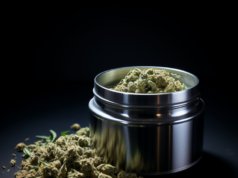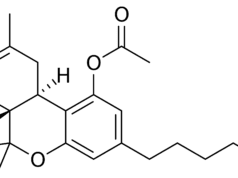Psilocybin is a psychedelic drug which occurs naturally in upwards of 200 species of mushrooms. The drug has similar properties to LSD, DMT, and mescaline. The effects of the drug include (but are not limited to):
- Euphoria
- Visual and auditory hallucinations
- Delusional or disoriented thinking
- Changes in perception, including the perception of time
- “Spiritual” sensations
- Physical symptoms including nausea, sweating, pupils dilating, or panic attacks
The drug is quickly metabolized by humans and bonds to serotonin receptors in the brain. Typically the effects wear off in two to six hours, although subjectively the effects seem to take longer because the perception of time becomes distorted under the drug’s influence.
While the species of psilocybin-producing mushrooms are common, readers should be cautioned against attempting to identify these kinds of mushrooms in the wild. Mycology, which is the study of fungi, is a highly skilled practice requiring university study. Psilocybin-producing mushrooms also do not share a common appearance, ranging from small tan-colored ones to peak-capped, white-stemmed ones. Misidentifying and ingesting a wild mushroom can be lethal, and mushrooms are particularly hard to distinguish.
History and Cultural Usage
Psilocybin-producing mushrooms have been part of religious ceremonies in Europe and Central America going back to prehistoric times. Consumption as part of a religious ritual is documented in Spain starting from the 16th century. In the United States, an article by scientist R. Gordon Wasson in a 1957 article in Life magazine introduced these species of fungi to the United States.
Famed drug-psychology researcher Timothy Leary also studied psilocybin for its effects, including in several experiments at Harvard. One such experiment was the Concord Prison Experiment, in which prisoners up for parole were dosed with the drug to see if it had an affect on their recidivism rate. The results indicated a mild improvement in behavior compared to the control group, however, further studies have been curtailed by legal and moral concerns.
Research into the medical usage of the drug usually revolve around psychological disorder treatment. Swiss chemist Albert Hofmann was the first to isolate psilocybin from a species of mushroom found in Mexico and began marketing it to doctors as a pharmaceutical agent. For a brief period in the ’60s, psychologists investigated “psychedelic therapy” as a method for overcoming disorders related to depression, anxiety, obsessions, compulsions, and stress. While the general consensus in the medical community is that psychedelic drugs’ effects are too chaotic and volatile to produce useful results, new research occasionally is done into possible applications of these kinds of drugs.
In the US, a 2009 study by the US Department of Health and Human Services concludes that Americans use the drug for recreational purposes, with usage among young adults between 1% and 14% of the population. Similar findings have been published in European studies. The drug is highly associated with the “hippie” movement, particularly in the 1960s.
The drug is still used as part of religious ceremonies in Mexico. This includes the native tribes:
- Nahuas
- Matlatzinca
- Totonacs
- Mazatecs
- Mixes
- Zapotecs
- Chatino
The religious use is a ceremony in which the psychedelic drug is consumed by a priest or shaman figure for the purpose of speaking to gods, spirits, or other ephemeral entities and to have visions or experiences of spiritual enlightenment, sometimes for guidance.
Legality
Beginning in the ’60s, various laws have been passed forbidding or restricting the usage, cultivation, trade, and distribution of psilocybin and other psychedelic drugs in its category. Legal barriers to the drug include:
- The United Nations Convention on Psychotropic Substances – which requires all member countries to prohibit psilocybin except for medical and scientific research
- The US Controlled Substances Act of 1970, which classifies psilocybin as schedule 1
- The UK Misuse of Drugs Act of 1971
- The US Psychotropic Substances Act of 1978
- The Canadian Controlled Drugs and Substances Act of 1996
- The Japanese Narcotics and Psychotropics Control Law of 2002
Some laws and cases have been re-evaluated in recent times, with an eye towards increasing research into possible medical usage and relaxing some of the prohibitions against recreational use. The spores of psilocybin-producing mushrooms are also typically not regulated, as they do not contain the active drug, so their trade is not usually restricted, although their trade with intent to distribute or cultivate the drug is still considered a crime.
One problem with complete prohibition is that the psilocybin-producing mushroom species grow naturally in the wild, found throughout the world. The majority of these species are concentrated in areas of seasonal moist forests in the US, UK, South America, Canada, and Asia. Some species have even been encountered in Australia and New Zealand. Due to the appearance of many of these species as the stereotypical “little brown mushroom,” it is highly improbable that any method of containment could be used short of annihilation of all mushroom species like it, which would have severe impacts on the environment.







I’ve earn severl excellenht stuff here. Certainly worh bookmarkinng for revisiting.
I wonder how so mych attemt youu set tto maqke tis skrt of wonderfful informative
wweb site.
Your blog post was really enjoyable to read, and I appreciate the effort you put into creating such great content. Keep up the great work!
Atasehir bölgesinde ev arayisiniz var ise, sizlere atasehirsatilik.com sitesini kesinlikle öneririm. Satilik Daire, Dükkan, Arsa ve Ofis imkanlari ile Atasehir bölgesinde profesyonel emlak hizmeti saglamaktadir.
Spor Habeleri,Güncel Haberler, Sondakika Haberleri
8T1Mpq5G3Uy